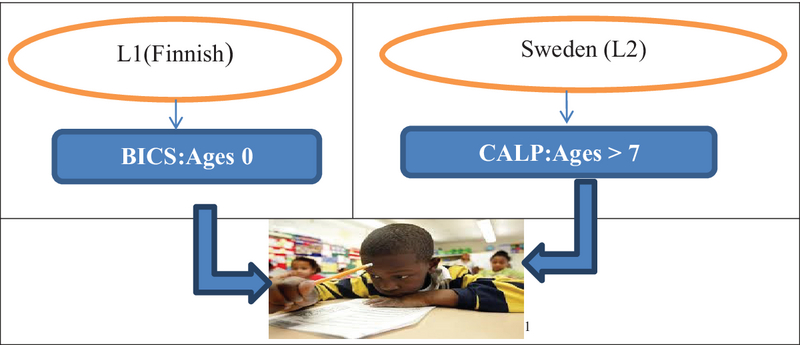Modelling A Here-And-Now Approach In Building Linguistic Capital
DOI:
https://doi.org/10.18502/kss.v1i1.439Abstract
Research findings in language acquisition and language and education show that there is a close link between cognition and academic language development. Children who have acquired and or learned academic language in their first language, they are likely to benefit cognitively more in their education than those who have not. As a consequence, the latter group may be the risk of becoming cognitively stagnant in their future education. These researchers advocate that the use of first language as an instructional language is not only educationally compulsory but also is a part of their rights. To them, teaching in children’s first language is a way of building what is in this paper called linguistic capital. However, the question of how this formation has to be executed and related issues including but not restricted to what appropriate resources would be needed to enable the formation to happen still remain to be seen. This paper therefore has a two-fold aim. Firstly, this paper intends to provide a theoretical apparatus for building linguistic capital. Secondly, it also aims to present some possible resources for building linguistic capital. As a preliminary work, this paper is then expected to be an invitation for further discussions and or debates on the issue.
Keywords: BICS, CALP, CUP
References
N. Chomsky, in Rules and representations, Basil Blackwell, Oxford, 1980.
N. Chomsky, in Language and Mind, Cambridge University Press, New York, USA, 3rd ed edition, 2006.
E. V. Clark, in First Language Acquisition, Cambridge University Press, Cambridge, UK, 2009.
J. Cummins, Cognitive/Academic Language Proficiency, Linguistic Interdependence and the Optimun age question and other matters Working Papers on Bilingualism, Toronto, Canada, Ontario, Institute for Studies in Education (1979).
J. Cummins, Linguistic Interdependence and the Educational Development of Bilingual Children, Bilingual Education Paper Series, 3(2) (1979).
J. Cummins, in The Role of Primary Language Development in Promoting Educational Success for Language Minority Students, Retrieved from, 1984.
S. Curtiss, The development of human celebral laterialization, D Frank Benson & Eran Zainel (Eds.), in The dual brain, New York, Gulfford Press, 1985.
S. Curtiss, S. Krashen, V. Fromklin, D. Rigler, and M. Rigler, Language Acquisition after Critical Period: Genie as of April 1973 (1973).
K. Hakuta, E. Bialystok, and E. Wiley, Critical evidence: a test of the critical-period hypothesis for second-language acquisition, Psychol Sci, 14(1), 31–38, (2003).
J. S. Johnson and E. L. Newport, Critical period effects in second language learning: the influence of maturational state on the acquisition of English as a second language, Cognit Psychol, 21, 60–99, (1989).
J. S. Johnson and E. L. Newport, Critical Period Effects in Second Language Learning: The Influence of Maturational State on the Acquisition of English as Second Language, Cognition, p. 39, (1991).
S. P. Kocu, Menggunakan Dialek Melayu Papua dalam Menjelaskan Konsep-konsep dan Prosedur Matematika kepada Siswa SD di Papua, Seminar Nasional Bahasa Ibu VIII, Universits Udayana, Bali, (2015).
S. D. Krashen, in Principles and Practice in Second Language Acquisition, Pergamon Press, 1982.
E. H. Lenneberg, On Explaining Language. Science, New Series, 164(3880), 635– 643,http://links.jstor.org/sici?sici=0036-8075%2819690509%293%3A164% 3A3880%3C635%3AOEL%3E2.0.CO%3B2-J, (1969).
Y. S. Quijano and O. Eustaquio, The Mother Tongue as a Bridge Language of Instruction in Two Schools in La Paz, Agusan del Sur, the Philippines: A Case Study, in Mother Tongue as Bridge Language of Instruction and Experiences in Southeasr Asia, M. Redmond, Ed., SEAMEO, Bangkok, 2009.
W. Siltragool, S. Petcharugsa, and A. Chouenon, Bilingual literacy for the Pwo Karen Community in Omkoi District Chiangmai Province: a case study from Thailand, in Mother Tongue as Bridge Language of Instruction: Policies and Experiences in Southeast Asia, M. Redmond, Ed., SEAMEO, Bangkok, 2009.
U. Siren, The Mother Tongue as a Bridge Language of Instruction in Cambodia, in Mother Tongue as Bridge Language of Instruction: Policies and Experiences in Southeast Asia, M. Redmond, Ed., SEAMEO, Bangkok, 2009.
T. Skutnab-Kangas and P. Toukomaa, in Teaching Migrant Children’s Mother Tongue and Learning the Language of the Host Country in the Context of Socio-Cultural Situation of the Migrant Family, Retrieved from Paris, France, 1976.
N. Tzourio-Mazoyer, L. Petit, A. Razafimandimby, F. Crivello, L. Zago, G. Jobard, M. Joliot, E. Mellet, and B. Mazoyer, Left hemisphere lateralization for language in righthanders is controlled in part by familial sinistrality, manual preference strength, and head size, J Neurosci, 30(40), 13314–13318, (2010).

